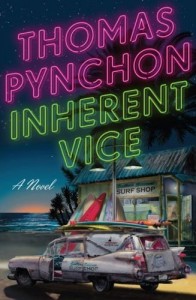July 3, 2014
Tom Pynchon’s Liquor Cabinet documents the booze in Thomas Pynchon’s novels
by Eliza Gilmore
Books inspire books; books inspire blogs; blogs inspire blogs; and blogs inspired by books inspire books, which then become movies. The most recent mutation of the “Julie/Julia”-type online literary project is “Tom Pynchon’s Liquor Cabinet,” one man’s ambitious attempt to drink his way through “every drink in every Pynchon novel.”
The blog, which launched in May, is a no-frills encyclopedia of booze. Images of Thomas Pynchon’s nine books lead to a list of every drink mentioned in said book, page number, and a link to Drunk Pynchon blogger’s (as dubbed by The Guardian) “review” of said drink.
Of the six books Drunk Pynchon blogger has annotated, there are 124 drinks mentioned, ranging from “1911 Hochheimer” (Gravity’s Rainbow, 652) to “Vodka with milk, with canned vegetable soup, with watermelon juice” (V., 18). Needless to say, the blogger hasn’t gotten very far yet. Nor has he been so adventuresome, pursuing Tequila Sunrise (Bleeding Edge, 77) in lieu of “A glazed jug of some liquid brain damage flavored with dill and coriander and distilled… from oatmeal” (Gravity’s Rainbow, 568).
Like any effort in the vein of post-modern author reverence, the Drunk Pynchon blog is born out of both frivolity and earnestness. The fact that Pynchon’s oeuvre resembles an encyclopedia of obscure cocktails and absurdist concoctions is the very type of postmodernist technique that must drive formalists crazy. Whether the author intended the taste of a certain drink to play an integral part in the “meaning” of a passage, or whether his specificity is merely out of entropic play, is unknowable.
Given Pynchon’s aversion to speaking to the press, the reader is unlikely to find any sort of formal explanation. Of course, the mystery surrounding Pynchon is integral to his standing as a sort of mythic figure in contemporary literature, and certainly gives appeal to dissecting his work by any means necessary. At face value then, Drunk Pynchon’s project seems to simply be the latest in a series of artificial and absurdist efforts at accessing the inaccessible author himself—not Thomas Pynchon, but “Tom.” The Guardian writes about the blog:
It’s the sort of project only Thomas Pynchon can inspire—the author whose devoted fans hold an annual Pynchon in Public day, have created a huge playlist of songs mentioned in Inherent Vice and extensively, obsessively annotated his books.
For his part, the Drunk Pynchon blogger does not seem to be tasting his way through Pynchon’s catalogue in order to provide some richer, synesthesia-induced reading of Pynchon’s work. Nor does he adopt the pseudo-intellectual Frat-boy tone you might expect from someone embarking on such a, um, indulgent project. His posts consist mainly of a description of the flavor, a brief mention of textual context, and a photo of the drink, typically next to the respective book cover or open page. He enthusiastically encourages any reader to alert him if he’s missed a drink in any of the books. He even invited readers over for Beaujolais when his blog started to get popular.
Drunk Pynchon blogger is not sipping his way through the books in order, but rather swigging all over the place, skipping between chapters and books and enjoying the palette-driven experimentalism of it all. For a postmodern author, that methodology seems wholly appropriate.
